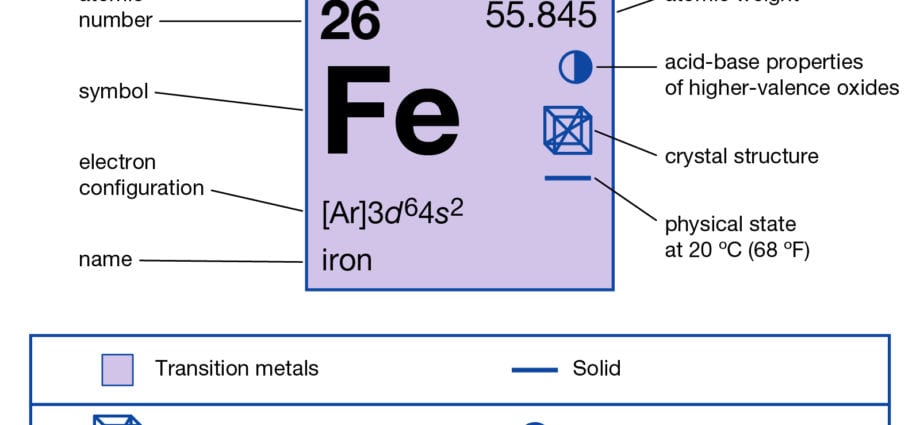Contents
Iron is mainly found in blood, bone marrow, spleen, and liver. The body of an adult contains 3-5 g of iron, of which 75-80% falls on the hemoglobin of erythrocytes, 20-25% are reserve and about 1% is contained in respiratory enzymes that catalyze the processes of respiration in cells and tissues.
Iron is excreted in urine and sweat (with urine about 0,5 mg / day, with then 1-2 mg / day). Women lose 10-40 mg of iron monthly through menstrual blood.
Iron rich foods
Indicated approximate availability in 100 g of product
Daily iron requirement
- for men – 10 mg;
- for women – 18 mg
- for older women – 10 mg.
The need for iron increases
For women – with heavy bleeding during menstruation, during pregnancy and breastfeeding.
Iron absorption
For optimal absorption of iron, normal secretion of gastric juice is required. Animal protein, ascorbic acid and other organic acids improve the absorption of iron, so the iron of vegetables and fruits rich in vitamin C and organic acids is well absorbed.
The absorption of iron is facilitated by some simple carbohydrates – lactose, fructose, sorbitol, as well as amino acids – histidine and lysine. But oxalic acid and tannins impair the absorption of iron, so spinach, sorrel, blueberries, which are rich in iron, cannot serve as a good source of it.
Phosphates and phytins, found in grains, legumes and some vegetables, interfere with the absorption of iron, and if you add meat or fish to these foods, the absorption of iron improves. Also, strong tea, coffee, a large amount of dietary fiber, especially bran, prevent the absorption of iron.
Useful properties of iron and its effect on the body
Iron is involved in the formation of hemoglobin in the blood, in the synthesis of thyroid hormones, and in protecting the body from bacteria. It is necessary for the formation of immune defense cells, it is required for the “work” of the B vitamins.
Iron is a part of more than 70 different enzymes, including respiratory, which provide respiration in cells and tissues, and are involved in the neutralization of foreign substances entering the human body.
Interaction with other essential elements
Vitamin C, copper (Cu), cobalt (Co) and manganese (Mn) promote the absorption of iron from food, and the additional intake of calcium (Ca) preparations interferes with the absorption of iron by the body.
Lack and excess of iron
Iron deficiency signs
- weakness, fatigue;
- headache;
- hyperexcitability or depression;
- palpitations, pain in the region of the heart;
- shallow breathing;
- discomfort of the gastrointestinal tract;
- lack or perversion of appetite and taste;
- dryness of the mucous membrane of the mouth and tongue;
- susceptibility to frequent infections.
Signs of excess iron
- headaches, dizziness;
- loss of appetite;
- drop in blood pressure;
- vomiting;
- diarrhea, sometimes with blood;
- kidney inflammation.
Factors affecting the content in products
Cooking food over high heat for a long time reduces the amount of absorbed iron in the food, so it is best to choose cuts of meat or fish that can be steamed or lightly fried.
Why iron deficiency occurs
The content of iron in the body depends on its absorption: with iron deficiency (anemia, hypovitaminosis B6), its absorption increases (which increases its content), and with gastritis with reduced secretion, it decreases.










